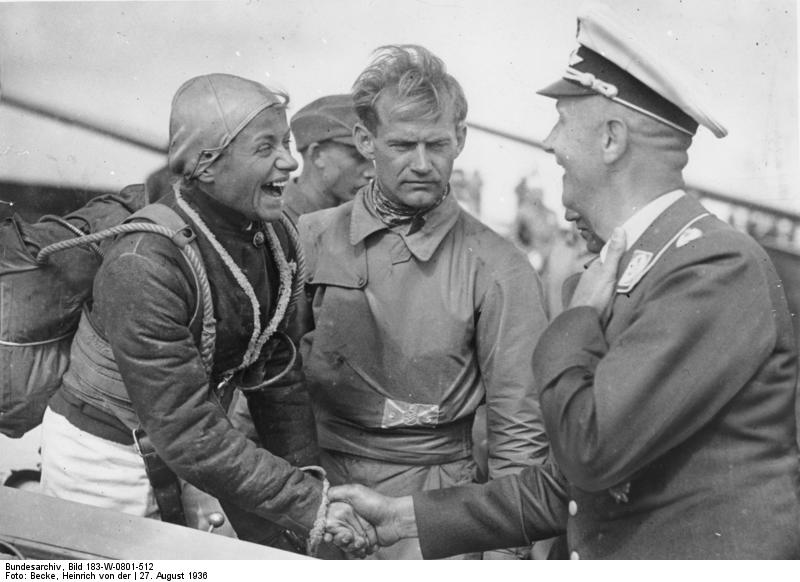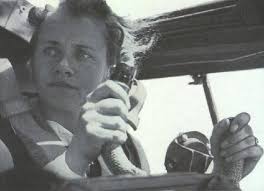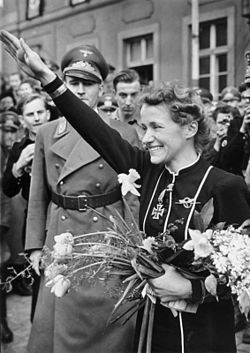This one’s a bit tough. Hanna Reitsch was simultaneously a very complicated, and a very simple person: she loved to fly and would pretty much love anyone who let her fly – and the person who gave her airplanes was Hitler.
But, holy shit, could she fly.
This is an excerpt from her memoir, “The Sky My Kingdom”

Hanna Reitsch in 1938
One day in April, 1944, Otto Skorzeny* introduced himself to me over the telephone and said he was anxious to meet me. This was the man whose name had become a by-word as the pilot** who had rescued Mussolini by helicopter from an hotel in the Abruzzi Moutains where he was held prisoner by the Badoglio Government. Skorzeny, it appeared, had recently been told by Himmler about our project and had himself been concerned in the development of special weapons. He was already in contact with those in the Navy who saw in the use of one-man torpedoes and frogmen a chance of bringing about a last-minute change in the courses of the war in Germany’s favour. Quite independently of us, Skorzeny had also come on the idea of the piloted V-1*** and had been anxious to meet me in order to discuss it.

V-1 “Buzz Bomb” cruise missile (source)
When he saw how the situation lay, Skorzeny set to work in characteristic fashion, sweeping aside all objections and obstacles with the same simple pretext, “Hitler had vested him with full powers and had expressly called for a daily progress report.”
Even today it seems to me almost incredible that a team of engineers and constructors succeeded in converting a V-1 in four of five days. The piloted V-1 was given the code-name of “Reichenberg” and was kept strictly on the secret list. Only a few people knew of its existence and not even those who worked on the normal V-1 were let in on the secret.
Various adaptations of the pilotless V-1 were constructed, using standard components already in production. The first of the new models was a single-seater V-1 with cushioned skids and a pilot’s seat placed directly behind the wing. As this model was for training, it was also provided with a power-unit and landing-flaps.
The second model was a two-seater V-1 with one seat placed in front and the other behind the wing. It was fitted with dual controls and, being intended for training school use, had no power unit.
Landing a V-1 was at all times an extremely difficult and dangerous operation and, even when specially trained, pilots of average ability could never be certain of surviving the attempt. If our project was to come to fruition at all, we had to do our best to keep down the fatality rate among the men on whom the entire training scheme depended, namely, the instructors, and those were accordingly most carefully picked from among the best of the volunteers.
The third model was the single-seater, operational V-1, with power-unit but without skids or landing flaps. In other words, it could not be landed – its first flight would also, inevitably, be the last.
I volunteered to test the prototype, but the experimental station at Rechlin insisted on using their own pilots.
On a warm summer’s day, Otto Skorzeny and I attended the first test at Larz. On arriving, we found the plane ready to  start. The V-1 was hanging under the right wing of the Heinkel III bomber. Since the allies had captured the launching sites in the Pas De Calais area, the pilotless V-1s had no longer been launched by catapult as their radius of action was insufficient to carry them to their objective from platforms inside Germany. They were now carried by an He III and launched from the mother-plane from a point nearer their target. A catapult start was also out of the question for the piloted V-1 on account of its high accelleration (about 17Gs) and it was therefore to be launched in the same way.
start. The V-1 was hanging under the right wing of the Heinkel III bomber. Since the allies had captured the launching sites in the Pas De Calais area, the pilotless V-1s had no longer been launched by catapult as their radius of action was insufficient to carry them to their objective from platforms inside Germany. They were now carried by an He III and launched from the mother-plane from a point nearer their target. A catapult start was also out of the question for the piloted V-1 on account of its high accelleration (about 17Gs) and it was therefore to be launched in the same way.
Fascinated, we followed the Heinkel as it took off with its burden and climbed higher and higher. Then the moment came when we saw the test pilot detach his plane from the bomber and drop away in the V-1 like some small, swift bird.
The pilot flew in tight turns until, on a dead-straight course, he began to lose height, gliding at an ever steeper angle towards the earth. It did not take us long to realize that this behavior of the machine was in no way intended by the pilot. The machine disappeared from sight and shortly after we heard an explosion in the distance and saw a column of black smoke rising in the summer air. For half an hour we waited, fearing to hear the news, until at last the report came through that the pilot was severely injured but still alive.
It transpired that the crash had been caused, not by some structural defect in the aircraft, but through the pilot’s own inadvertence. He had unintentionally pressed the catch to the sliding hood of the cockpit and, half stunned by the force of the air current, had lost control over the plane.
The day after, a second pilot took off in the V-1. He, too, came to grief, though escaping with his life.
From then on, Heinz Kensche and I were allowed to take over the prototype tests of the piloted V-1.
My first flight passed without incident and the next eight or ten flights were also successful, though not without their awkward moments.


Awarded the Iron Cross
I feel the need to place a mandatory disclaimer, here: I do not approve of Reitsch’s nazism or her militarism. My impression of her, from her writings and what I can glean of her history, is that she was politically naive. She was so narrowly focused on doing what she wanted, and being herself, that she didn’t spare much of a thought for the possible consequences of her actions. In a sense, that’s the “warrior tradition” in humanity: warriors are expected to let all the higher-order moral calculus go out the window and do the best they can with the situation, which Reitsch certainly did. I always find it problematic when someone goes about being, say, a great bomber pilot: well, they’re certainly skillful at dropping bombs but they’re dropping bombs on people that aren’t actually threatening them. Reitsch simply ignored all that, and flew. We can’t, and shouldn’t, ignore that – which means we’ve got to factor everything together as we assess an individual’s impact, contribution, and value.
When their wars started going badly for them, the fascists resorted to using humans as the guidance systems for flying bombs. Reitsch is characteristically open (and politically naive) about the idea of building a piloted V-1 that has no landing gear, so she can help train other pilots to make one-way flights. The Japanese had their own suicide plane, the Yokosuka Ohka.
One of the issues I’ve long been on the fence about is the idea of women serving in the military; it seems to be less of an issue than it used to be, but as an amateur military historian, I used to ask guys who’d say “no women in the military” if they’d ever heard of Hanna Reitsch or Lyudmila Pavlichenko, etc. Usually to blank stares. I don’t think anyone should be in the military, which significantly simplifies my position, but it’s clear that women are just as susceptible to being ideologized into violence as men, and they’re just as good at it.
Youtube: interview with Hanna Reitsch (20 min)
(*Skorzeny was a “fascinating character” in his own right, and a fantastic pilot. Accounts I have read elsewhere of Skorzeny’s life don’t mention his encounter with Reitsch, but it’s credible.)
(** Typical of Reitsch, she only saw Skorzeny as a “pilot”, he was more of a general-purpose paladin. And Skorzeny was flying a Feisler Storch, not a helicopter – through an amazing feat of flying in which he drove the overloaded Storch off a cliff, to get it airborne. I’m surprised a pilot like Reitsch would mistake a Storch for a helicopter; I’m not sure what is going on there.)
(*** If you just thought “you have got to be fucking kidding me!” Yeah. No.)
I am also puzzled by Reitsch’s comment about wanting to bail out of a V-1. That doesn’t seem possible, with the jet engine intake right above and behind the cockpit. Maybe she meant that she was going to try to die faster.
I didn’t want to stray from the main point of this piece by including the lengthy follow-on account by Reitsch of some of her adventures in the V-1. But I’ll put two here:
On one occasion, for example, the pilot of the He III had just released me from beneath the bomber’s wing, when his plane grazed the rear of the V-1. There was a loud rending noise, as if the tail of my plane had been broken right off. Though only just able to continue to control the plane, I managed to make a smooth landing, finding, when I inspected it, that the tail had been crumpled and twisted to the right through an angle of almost thirty degrees. It seemed a miracle that it had not come right off.
On another occasion I was testing the behavior of the two-seater model of the V-1 at a wide range of speed along an inclined flight-path, flying at speeds up to 530mph. During the test, a sack of sand, which had been wedged in the front seat on my instruction to supply extra weight, somehow broke loose and shifted position. In blissful ignorance, I tried to flatten out at speed and suddenly found out that I could not move the elevator. I had not enough height, or time, to be able to bail out by parachute and had to risk all on a last, faint chance of saving myself and the plane. Just before the machine reached the ground, I pushed her nose down, and then, with all the response I could get from the elevator, quickly pulled out again. This maneuver checked the plane just enough for me to be able to make a landing, though an extremely hard one which splinterest the skids and the hull. I emerged without a scratch.

Ian Kershaw, Hitler – 1936-1945: Nemesis –
Pierce R. Butler@#1:
I’d never seen that before; thank you.
Reitsch was very unapologetic – even thoughtless (why I call her “naive”) about her role in the war. There are a number of interviews with her before her death and she didn’t change her views much, if at all.
I’d categorize her as a “nationalist ideologue” – or an authoritarian follower (per Altemeyer) – someone who is prepared to hero-worship and accept that her country wants (whatever). For a skeptic and an anarchist, like myself, that is a very very foreign viewpoint to imagine. She seems to have been focused on the personality cult of Hitler and nationalism, rather than all the more crazy/toxic ideology that went along with it, though certainly the idea of an experienced and dedicated pilot training other pilots to fly suicide missions: it’s problematic to say the least.
Very interesting.
I remember coming across Reitsch’s name many years ago (wish I could remember where), in a description of that last flight out of Berlin. I remember that she flew a Messerschmitt Bf-108 (a very low-powered trainer, mind, not a high-performance fighter like the Bf-109) out of Berlin in the last days. The Soviet Air Force completely dominated the skies – how she made it out alive is beyond me.
But that’s nothing compared to that story of the “smooth landing” with the tail twisted trough 30º. That’s just an indescribable level of skill (not to mention, sang froid).
What a waste of guts and skill. I’ve read someone (C.F. Forester, maybe?) who said that, among the many crimes attributable to fascism, we should not forget how they took good human qualities – like loyalty, brains, and courage – and twisted them to the most perverted ends. (I am paraphrasing from ancient memory here).
Bizarre to read about the “helicopter” in that excerpt though! The Luftwaffe didn’t have any operational powered rotary-winged aircraft in WWII; surely Reitsch would know that. I wonder if this was some weird editor’s error.
quotetheunquote@#3:
Reitsch’s interrogation/debrief is here
More analysis here
Reitsch was a full bird colonel, in US rankings; just below a general rank. So, even in the collapsing military establishment, she could expect to demand aircraft, cars, escorts, whatever. This part of the story is bizzare, to me: she got a lot of people killed to fly escort on that flight; I have long wondered whether she was planning on trying to “pull a Skorzeny” and fly Hitler out of Berlin, snatching him from the jaws of the Red Army.
The full account of her splash-landing near the Fuhrerbunker, Greim’s injury, and their subsequent escape – it’s the stuff of hollywood superhero movies.
I found this on the Focke-Achgelis Fa 223 Wikipedia page:
https://en.wikipedia.org/wiki/Focke-Achgelis_Fa_223
“When Otto Skorzeny was planning his raid to abduct captured Italian dictator Benito Mussolini from the Albert Rifugio hotel on the Gran Sasso in September 1943, his original choice of aircraft was a Fa 223.[15] The Fa 223 would be able to land directly in front of the hotel.[15] However, the chosen aircraft broke down while en route, and Skorzeny instead was forced to use a Fieseler Fi-156.[15]”
It would seem that Reitsch was not entirely incorrect. The mission was planned using a helicopter but it broke down. It makes sense that she would remember the plan that was drilled into memory during the planning phase instead of the one-off improvisation using the Storch of the real event.
As to why such a talented woman would be so loyal to such a hideous regime I assume it was gratitude and a desire to repay the favor of promoting her flying career in a time when women otherwise had few prospects. That and and not knowing, or being willing to admit knowing, of the crimes of the regime. She clearly loved flying and the internal bargain with herself may have been that as long as she required to directly participate she would focus on aviation.
This may be too facile a reading as V-1 production was linked to forced labor from concentration camps and it sounds inconceivable that the link would go unnoticed. Then again it isn’t uncommon for people to ignore atrocities, large and small, if they get to do what they want most of the time. It is one of the central undertakings of philosophy, given that neither good not evil is ever seen in its pure form, to determine just how much evil can be tolerated when pursuing good.
The issue is further muddied by the cultural norm that most people have more difficulty assigning evil intent and behavior to a woman. While the easily available evidence seems to show her as focused on aviation while only brushing against the horrors of the regime indirectly she may, in fact, have fully known about and delighted in the inhumanity shown to the enemies of the German state.